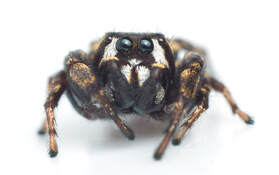About this guide
This guide was created to provide information about some common, but still unfamiliar, insects and spiders spotted in homes across Oregon. There are over 20,000 species of insects in Oregon, therefore this is not a complete guide. This guide is intended to help residents make informed decisions about pest control. We hope to reduce some of the unfounded fears and misconceptions about insects and spiders.
A note about insects and spiders.
 Jumping spiders, like this Metaphidippus manni are common, harmless, and fascinating.
Jumping spiders, like this Metaphidippus manni are common, harmless, and fascinating.
Insects and spiders have a bad reputation for being dangerous, deadly, destructive or disgusting. This is an unfair characterization of the largest group of organisms on the planet. Of the more than one million known insects, only a very small percentage of these are considered “pests”, or species that cause problems for people. There are more myths about the threat of insects and spiders than can fit into this pamphlet, but you should know: Most insects and spiders are completely harmless to people. Insects enter homes looking for food (often in the form of other insects or food crumbs), for shelter, or completely by accident. Some insects are capable of causing very severe economic damage to crops and structures, and others can spread disease, but most insects and spiders are not problematic in any way.If you find an insect that might be a pest, it’s essential to know what it is before hiring exterminators or applying pesticides. The Oregon Department of Agriculture provides free insect identification for members of the public and for agriculture industry professionals. In many cases, no action is necessary because the insect is not a pest. There may be solutions besides pesticides that can help reduce insect populations. However, not every insect pest problem has a simple solution. In many cases, control methods are difficult, costly, or simply unknown.
Important Notice! Do not send photos of suspected injuries (bites and stings), biological samples,
or other bodily materials for insect identification or diagnosis!
or other bodily materials for insect identification or diagnosis!
Our entomologists are not health care professionals. Oregon Department of Agriculture cannot identify an insect or spider from descriptions of symptoms or pictures of insect bites or stings. They will not offer any advice regarding injury diagnosis or health care. For information about insect bite treatment or other health concerns, please consult a health care professional.